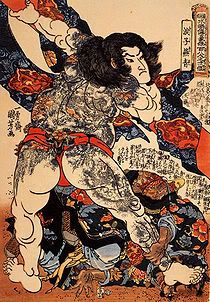
The OED gives the etymology of tattoo as "In 18th c. tattaow, tattow. From Polynesian (Tahitian, Samoan, Tongan, etc.) tatau. In Tahitian, tatu." The word tatau was loaned into English, the pronunciation being changed to conform to English phonology as "tattoo". Sailors on the voyage later introduced both the word and reintroduced the concept of tattooing to Europe.
Tattoo enthusiasts may refer to tattoos as "Ink", "Tats", "Art", "Pieces", or "Work"; and to the tattooists as "Artists". The latter usage is gaining greater support, with mainstream art galleries holding exhibitions of both traditional and custom tattoo designs. Copyrighted tattoo designs that are mass-produced to tattoo artists are known as flash, a notable instance of industrial design. Flash sheets are prominently displayed in many tattoo parlors for the purpose of providing both inspiration and ready-made tattoo images to customers.
The Japanese word irezumi means "insertion of ink" and can mean tattoos using tebori, the traditional Japanese hand method, a Western style machine, or for that matter, any method of tattooing using insertion of ink. The most common word used for traditional Japanese tattoo designs is Horimono. Japanese may use the word "tattoo" to mean non-Japanese styles of tattooing.
In Taiwan, Atayal tribe facial tattoo named "Badasun"; demonstrate adult man can protect their homeland and adult woman is qualify to weave cloth, housekeeping.[citation needed]
The anthropologist Ling Roth in 1900 describes four methods of skin marking and suggests they be differentiated under the names of tatu, moko, cicatrix and keloid.
No comments:
Post a Comment